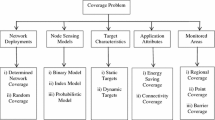Abstract
The advances in sensors and IOT technologies has prompted a plethora of applications, many of them require a large number of sensors distributed over a large geographical area. These sensors collectively form a network with a sole purpose of providing the application with high fidelity representation of the actual physical world. The Quality of Coverage (QoC) metric is typically refers to how well this representation is. The issue of coverage has been studied in the literatures, however, most research focused on various aspects of physical sensor network coverage with less attention to the diverse requirements of the applications which use the underlying sensor layer. In this paper, we introduce multiple metrics to measure the quality of coverage which can then be tailored to meet the requirements of different types of applications. In addition, we propose algorithms to measure these metrics and use evaluation techniques to demonstrate and test the performance of proposed algorithms.












Similar content being viewed by others
References
Cardie M, Wu M (2004) Coverage problem in wireless ad hoc sensor networks, Handbook of sensor networks”, chapter 19. CRC Press
Wang B (2011) Coverage problems in sensor networks: a survey”, ACM Computing Survey, 43, 4, Article 32, 53 pages, October
Sharif M (2011) A new approach to compute convex Hull. Innovative Systems Design and Engineering, ISSN 2(3):2222–1727
Kamilaris A, Pitsillides A (2016) “Mobile phone computing and the internet of things: a survey”, DOI https://doi.org/10.1109/JIOT.2016.2600569, IEEE Internet of Things Journal
NB-IOT-feature list (2018) Release 13 (LTE Advanced Pro), 3rd Generation Partnership Project, 3GPP, http://www.3gpp.org/images/PDF/ R13_IOT_rev3.pdf, Accessed 12 Dec 2018
Mekkia K, Bajica E, Chaxela F, Meyerba F (2018) “A comparative study of LPWAN technologies for large-scale IoT deployment”, The Korean Institute of Communications Information Sciences. Publishing Services by Elsevier B.V
Patel P, Mehta M (2016) A survey-an energy efficient routing-protocol in DTN. International journal of advance research and innovative ideas in education, ISSN(O)-2395–4396 2(6):809–812
Bista B, Rawat D (2015) A robust energy efficient epidemic routing protocol for delay tolerant networks, 2015 IEEE international conference on data science and data intensive systems, pp. 290–296
Yao Y, Zheng W, Ren Z (2012) An energy-efficient routing algorithm for disruption tolerant networks, proceedings of the 2nd international conference on computer and information application
Singh S, Sharma R (2015) “Some aspects of coverage awareness in wireless sensor networks”, 4th international conference on eco-friendly computing and communication systems, Procedia computer science 70, pp 160–165, published by Elsevier B.V
Saha D, Das N, Bhattacharya B (2014) “Fast estimation of coverage area in a pervasive computing environment”, advanced computing, networking and informatics - volume 2, 19, smart innovation, systems and technologies 28, Springer International Publishing
Tao D, Wu T (2015) “A survey on barrier coverage problem in directional sensor networks”, IEEE sensors journal, volume: 15. Issue 2:876–885
Tan H, Hao X, Wang Y, Lau F, Lva Y (2013) “An approximate approach for area coverage in wireless sensor networks”, the 4th international conference on ambient systems, networks and technologies
Park J, Oh S (2012) A new concave Hull algorithm and concaveness measure for n-dimensional datasets. J Inf Sci Eng 28:587–600
Lalem F, Bounceur A, Bezoui M, Saoudi M, Euler R, Kechadi T, Sevaux M (2017) “LPCN: least polar-angle connected node algorithm to find a polygon Hull in a connected Euclidean graph”, ad hoc networks, pp.56–71, Elsevier
Pohl M, Feldmann D (2016) “Generating straight outlines of 2D point sets and holes using dominant Directionsor orthogonal projections”, Science and Technology Publications, SCITEPRESS
Wang X, Zhang H, Fan S, Gu H (Oct 2018) “Coverage control of sensor networks in IoT based on RPSO”, IEEE internet of things journal, volume: 5. Issue 5:3521–3532
L. Zhao, W. Liu, H. Lei, R. Zhang, Q. Tan (2016) “Detecting boundary nodes and coverage holes in wireless sensor networks”, Mobile information systems, volume 2016, article ID 8310296, 16 pages
Letkowski J (2012) “Applications of the Poisson probability distribution”, Western New England University, 2012
Author information
Authors and Affiliations
Corresponding author
Additional information
Publisher’s note
Springer Nature remains neutral with regard to jurisdictional claims in published maps and institutional affiliations.
Rights and permissions
About this article
Cite this article
Elsaadany, A., Khalil, K. Assessment of coverage quality of sensor networks for IoT applications. Peer-to-Peer Netw. Appl. 13, 320–332 (2020). https://doi.org/10.1007/s12083-019-00796-2
Received:
Accepted:
Published:
Issue Date:
DOI: https://doi.org/10.1007/s12083-019-00796-2




